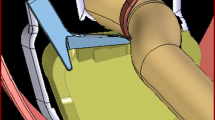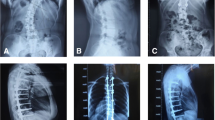Abstract
The traditional surgical treatment of severe spinal deformities, both in adult and pediatric patients, consisted of a 360° approach. Posterior-based spinal osteotomy has recently been reported as a useful and safe technique in maximizing kyphosis and/or kyphoscoliosis correction. It obviates the deleterious effects of an anterior approach and can increase the magnitude of correction both in the coronal and sagittal plane. There are few reports in the literature focusing on the surgical treatment of severe spinal deformities in large pediatric-only series (age <16 years old) by means of a posterior-based spinal osteotomy, with no consistent results on the use of a single posterior-based thoracic pedicle subtraction osteotomy in the treatment of such challenging group of patients. The purpose of the present study was to review our operative experience with pediatric patients undergoing a single level PSO for the correction of thoracic kyphosis/kyphoscoliosis in the region of the spinal cord (T12 and cephalad), and determine the safety and efficacy of posterior thoracic pedicle subtraction osteotomy (PSO) in the treatment of severe pediatric deformities. A retrospective review was performed on 12 consecutive pediatric patients (6 F, 6 M) treated by means of a posterior thoracic PSO between 2002 and 2006 in a single Institution. Average age at surgery was 12.6 years (range, 9–16), whereas the deformity was due to a severe juvenile idiopathic scoliosis in seven cases (average preoperative main thoracic 113°; 90–135); an infantile idiopathic scoliosis in two cases (preoperative main thoracic of 95° and 105°, respectively); a post-laminectomy kypho-scoliosis of 95° (for a intra-medullar ependimoma); an angular kypho-scoliosis due to a spondylo-epiphisary dysplasia (already operated on four times); and a sharp congenital kypho-scoliosis (already operated on by means of a anterior–posterior in situ fusion). In all patients a pedicle screws instrumentation was used, under continuous intra-operative neuromonitoring (SSEP, NMEP, EMG). At an average follow-up of 2.4 years (range, 2–6) the main thoracic curve showed a mean correction of 61°, or a 62.3% (range, 55–70%), with an average thoracic kyphosis of 38.5° (range, 30°–45°), for an overall correction of 65% (range, 60–72%). Mean estimated intra-operative blood loss accounted 19.3 cc/kg (range, 7.7–27.27). In a single case (a post-laminectomy kypho-scoliosis) a complete loss of NMEP occurred, promptly assessed by loosening of the initial correction, with a final negative wake-up test. No permanent neurologic damage, or instrumentation related complications, were observed. According to our experience, posterior-based thoracic pedicle subtraction osteotomies represent a valuable tool in the surgical treatment of severe pediatric spinal deformities, even in revision cases. A dramatic correction of both the coronal and sagittal profile may be achieved. Mandatory the use of a pedicle screws-only instrumentation and a continuous intra-operative neuromonitoring to obviate catastrophic neurologic complications.



Similar content being viewed by others
References
Bullmann V, Halm HFH, Schulte T, Lerner T, Weber TP, Liljenqvist UR (2006) Combined anterior and posterior instrumentation in severe and rigid idiopathic scoliosis. Eur Spine J 15:440–448
Byrd JA, Scoles PV, Winter RB, Bradford DS, Lonstein JE, Moe JH (1987) Adult idiopathic scoliosis treated by anterior and posterior spinal fusion. J Bone Joint Surg Am 69:843–850
Korovessis P (1987) Combined VDS and Harrington instrumentation for treatment of idiopathic double major curves. Spine 12:244–250
Savini R, Parisini P et al (1989) The surgical correction of severe vertebral deformities by combined anterior and posterior instrumentation. Prog Spinal Pathol 4:211–221
Shufflebarger HL, Grimm JO, Bui V, Thomson JD (1991) Anterior and posterior spinal fusion. Staged versus same-day surgery. Spine 16:930–933
Pellin B, Zielke K (1974) Severe scoliosis in adults and older, adolescents. 41 operated cases. Rev Chir Orthop Reparatrice Appar Mot 60:623–633
Savini R, Parisini P, Corbascio M, Prosperi L (1977) L’ halo trazione associata alla fisio kinesi terapia nel trattamento correttivo delle scoliosi con gravissimi deficit respiratori. C.O.M vol XLIII fasc. IV.: 353–360
Rinella A, Lenke L, Whitaker C, Kim Y, Park SS, Peelle M, Edwards C 2nd, Bridwell K (2005) Perioperative halo-gravity traction in the treatment of severe scoliosis and kyphosis. Spine 30:475–482
Compere EL (1932) Excision of hemivertebrae for correction of congenital scoliosis: report of two cases. J Bone Joint Surg 14:555–562
Wiles P (1951) Resection of dorsal vertebrae in congenital scoliosis. J Bone Joint Surg Am 33:151–154
Leatherman KD, Dickson RA (1979) Two-stage corrective surgery for congenital deformities of the spine. J Bone Joint Surg Br 61:324–328
Floman Y, Penny JN, Micheli LJ et al (1982) Osteotomy of the fusion mass in scoliosis. J Bone Joint Surg Am 64:1307–1316
Luque ER (1983) Vertebral column transposition. Orthop Trans 7:29
Tokunaga M, Minami S, Kitahara H et al (2000) Vertebral decancellation for severe scoliosis. Spine 25:469–474
Deviren V, Berven S, Smith JA et al (2001) Excision of hemivertebrae in the management of congenital scoliosis involving the thoracic and thoracolumbar spine. J Bone Joint Surg Br 83:496–500
Bridwell KH (2006) Decision making regarding Smith-Petersen vs. pedicle subtraction osteotomy vs. vertebral column resection for spinal deformity. Spine 31(19 Suppl):S171–S178
Tomita K, Kawahara N et al (2006) Total en bloc spondylectomy for spinal tumors: improvement of the technique and its associated basic background. J Orthop Sci 11:3–12
Bradford DS (1987) Vertebral column resection. Orthop Trans 11:502
Bradford DS, Tribus CB (1997) Vertebral column resection for the treatment of rigid coronal decompensation. Spine 22:1590–1599
Cheh G, Lenke LG et al (2008) Loss of spinal cord monitoring signals in children during thoracic kyphosis correction with spinal osteotomy. Why does it occur and what should you do? Spine 33:1093–1099
Luhmann SJ, Lenke LG, Kim YJ, Bridwell KH, Schootman M (2005) Thoracic adolescent idiopathic scoliosis curves between 70° and 100°. Is anterior release necessary? Spine 30:2061–2067
Kim YJ, Lenke LG, Bridwell KH, Kim KL, Steger-May K (2005) Pulmonary function in adolescent idiopathic scoliosis relative to the surgical procedure. J Bone Joint Surg Am 87:1534–1541
Smith-Petersen MN, Larson CB, Aufranc OE (1969) Osteotomy of the spine for correction of flexion deformity in rheumatoid arthritis. Clin Orthop Relat Res 66:6–9
Bridwell KH, Lewis SJ, Lenke LG et al (2003) Pedicle subtraction osteotomy for the treatment of fixed sagittal imbalance. J Bone Joint Surg Am 85:454–463
Shono Y, Abumi K, Kaneda K (2001) One-stage posterior hemivertebra resection and correction using segmental posterior instrumentation. Spine 26:752–757
Ruf M, Harms J (2002) Hemivertebra resection by a posterior approach: innovative operative technique and first results. Spine 27:1116–1123
Kawahara N, Tomita K, Baba H et al (2001) Closing-opening wedge osteotomy to correct angular kyphotic deformity by a single posterior approach. Spine 26:391–402
Smith JT, Gollogly S, Dunn HK (2005) Simultaneous anterior-posterior approach through a costotransversectomy for the treatment of congenital kyphosis and acquired kyphoscoliotic deformities. J Bone Joint Surg Am 87:2281–2289
Suk SI, Kim JH, Kim WJ et al (1998) Treatment of fixed lumbosacral kyphosis by all posterior vertebral column resection. Presented at: 5th international meeting on advanced spine techniques, Sorrento, Italy
Thomasen E (1985) Vertebral osteotomy for correction of kyphosis in ankylosing spondylitis. Clin Orthop Relat Res 194:142–152
Buchowski JM, Bridwell KH, Lenke LG et al (2007) Neurologic complications of lumbar pedicle subtraction osteotomy. A 10-year assessment. Spine 32:2245–2252
Farcy JP, Schwab FJ (1997) Management of flatback and related kyphotic decompensation. Spine 22:2452–2457
Wang MY, Berven SH (2007) Lumbar pedicle subtraction osteotomy. Neurosurgery 60(2 suppl 1):140–146
Asher M et al (2004) Safety and efficacy of Isola instrumentation and arthrodesis for adolescent idiopathic scoliosis. Spine 29:2013–2023
Tsirikos AI, Chang WN et al (2003) Comparison of one-stage versus two-stage anteroposterior spinal fusion in pediatric patients with cerebral palsy and neuromuscular scoliosis. Spine 28:1300–1305
Cobb JR (1948) Outline for the study of scoliosis. AAOS Instr Course Lect 5:261–275
O’Brien M, Kuklo T et al (2004) Spinal deformity study group. Radiographic Measurement Manual. Edition Medtronic Sofamor Danek
Di Silvestre M, Bakaloudis G, Lolli F, Vommaro F, Martikos K, Parisini P (2008) Posterior fusion only for thoracic adolescent idiopathic scoliosis of more than 80 degrees: pedicle screws versus hybrid instrumentation. Eur Spine J 17(10):1336–1349
Dolan LA, Weinstein SL (2007) Surgical rates after observation and bracing for adolescent idiopathic scoliosis. An evidence-based review. Spine 32:S91–S100
Weinstein SL, Dolan LA, Spratt KF et al (2003) Health and function of patients with untreated idiopathic scoliosis: a 50-year natural history study. JAMA 289:559–567
Dubousset J, Herring JA, Shufflebarger H (1989) The crankshaft phenomenon. J Pediatr Orthop 9:541–550
Graham EJ, Lenke LG, Lowe TG et al (2000) Prospective pulmonary function evaluation following open thoracotomy for anterior spinal fusion in adolescent idiopathic scoliosis. Spine 25:2319–2325
Anand N, Regan JJ (2002) Video-assisted thoracoscopic surgery for thoracic disc disease: classification and outcome study of 100 consecutive cases with a 2-year minimum follow-up period. Spine 27:871–879
Mack MJ, Regan JJ, McAfee PC et al (1995) Video-assisted thoracic surgery for the anterior approach to the thoracic spine. Ann Thorac Surg 59:1100–1106
Newton PO, Wenger DR, Mubarak SJ et al (1997) Anterior release and fusion in pediatric spinal deformity. A comparison of early outcome and cost of thoracoscopic and open thoracotomy approaches. Spine 22:1398–1406
Lenke LG, Newton PO, Marks MC et al (2004) Prospective pulmonary function comparison of open versus endoscopic anterior fusion combined with posterior fusion in adolescent idiopathic scoliosis. Spine 29:2055–2060
Shen J, Qiu G, Wang Y, Zhang Z, Zhao Y (2006) Comparison of 1-stage versus 2-stage anterior and posterior spinal fusion for severe and rigid idiopathic scoliosis—A randomized prospective study. Spine 31:2525–2528
Dobbs MB, Lenke LG, Kim YJ, Luhmann SJ, Bridwell KH (2006) Anterior/posterior spinal instrumentation versus posterior instrumentation alone for the treatment of adolescent idiopathic scoliotic curves more than 90°. Spine 31:2386–2391
Suk SI, Kim JH, Kim WJ, Lee SM, Chung ER, Nah KH (2002) Posterior vertebral column resection for severe spinal deformities. Spine 27:2374–2382
Suk SI, Chung ER, Kim JH, Kim SS, Lee JS, Choi WK (2005) Posterior vertebral column resection for severe rigid scoliosis. Spine 30:1682–1687
Conflict of interest
None of the authors has any potential conflict of interest.
Author information
Authors and Affiliations
Corresponding author
Rights and permissions
About this article
Cite this article
Bakaloudis, G., Lolli, F., Silvestre, M.D. et al. Thoracic pedicle subtraction osteotomy in the treatment of severe pediatric deformities. Eur Spine J 20 (Suppl 1), 95–104 (2011). https://doi.org/10.1007/s00586-011-1749-y
Received:
Published:
Issue Date:
DOI: https://doi.org/10.1007/s00586-011-1749-y




